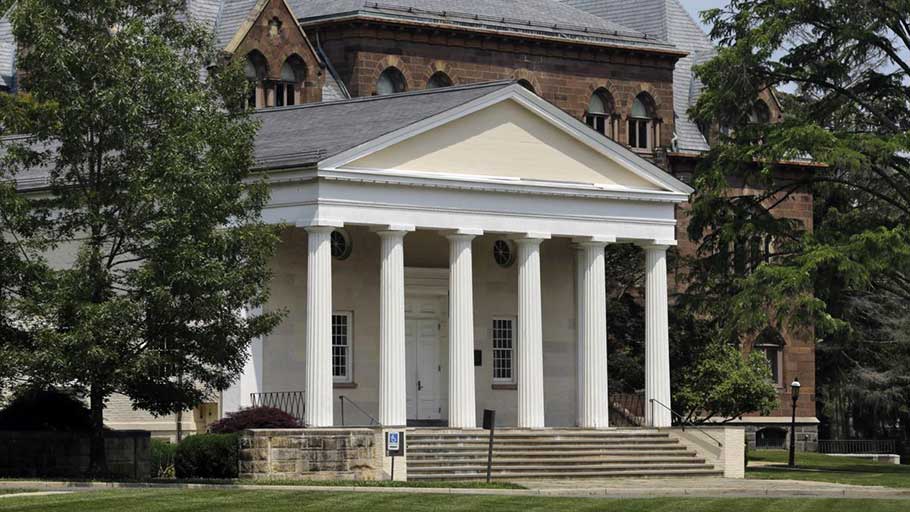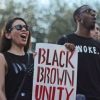Buildings at Princeton University’s Princeton Theological Seminary are pictured in Princeton, N.J. Last year, the university released a report on the school’s role in American bondage. Although the seminary did not own slaves and slave labor was not used on constructing the school, slave owners were major donors and responsible for as much as 40 percent of the seminary’s revenue. Photo by Mel Evans
By Wyatt Massey, Frederick News Post —
The Rev. Dr. Ernest Campbell said no, James Forman could not speak at his church service the next day.
Campbell was the senior pastor at Riverside Church, a predominantly white church on the west side of Manhattan. Forman, a black civil rights leader, wanted to read something to the congregation at the next day’s service on May 4, 1969, according to a history of the events written by Elaine Allen Lechtreck.
Forman was told he could distribute his materials outside the church before the service but he was not to disrupt the Sunday program.
The next day, Forman and six others walked to the front of the church. Campbell signaled for the organist to start playing so Forman’s words could not be heard. He waited for the organist to finish and, in front of a crowd of about 500 white people, Forman read his manifesto.
Forman wanted $500 million.
Forman, along with his work with the Student Nonviolent Coordinating Committee and Black Panther Party, was involved with the National Black Economic Development Conference. The conference was designed to advocate for black businesses and civil rights. It was there Forman helped write the “Black Manifesto” asking for $500 million. By their estimation, this broke down to $15 for every black person, or $104 a person in today’s money.
The $500 million was a form of reparations for the role white Christian churches and Jewish synagogues played in slavery.
“For centuries we have been forced to live as colonized people inside the United States, victimized by the most vicious, racist system in the world,” the manifesto states. “We have helped to build the most industrial country in the world. We are therefore demanding …”
The money was to be used, among other things, to create a southern bank to help African Americans buy land and establish farms, create a publishing industry for African Americans to contrast the white-dominated news field and create a black university in the South.
The congregation of Riverside Church reacted to Forman’s demands with outrage. Days later, Forman was served a court order stopping him from disrupting the church anymore.
However, Forman’s protest and sit-ins across the country led various church leaders from the Baptist, Episcopalian, Methodist and Presbyterian traditions to donate to African American-led businesses and nonprofits. However, the donations were a fraction of what Forman and other civil rights leaders were asking for and little money went to Forman’s National Black Economic Development Conference.
The apparent failure of 1969, though, may have a new audience in 2019.
The reparations movement is experiencing a renewed interest in the United States, whether those reparations are symbolic, material or financial. Democratic presidential candidates are talking about it on the campaign trail at the same time churches and religious universities are re-examining how they benefited from decades of human bondage.
The same Bible used to validate slavery is being used to justify repenting for those sins through reparations. With atonement a central part of the Christian faith, theologians say the religion should be leading the cause for reparations.
When the church owned people
American churches and religious schools were just as much a part of the brutal history of slavery as plantation owners, said Jennifer Oast, associate professor of history at Bloomberg University.
Oast began researching the topic as a doctoral candidate at the College of William and Mary in Williamsburg, Virginia. She was reviewing a list of enslaved African American children when she saw the listed owner as her college. That initial search led her to write the book “Institutional Slavery: Slaveholding Churches, Schools, Colleges, and Businesses in Virginia, 1680-1860.”
The Episcopal, Presbyterian and Catholic churches all have histories of owning slaves, Oast said. The Episcopal Church used slaves as part of the compensation packages for its ministers. Members of the Presbyterian Church donated their slaves to the church to be hired out. The church could then keep the profits.
“There’s a lot of overlap actually, between the free schools and universities and the churches because so many schools and universities were founded by churches,” Oast said. “So, I would say that you would not have seen such a robust religious establishment in America as early as you did if it hadn’t been for the unpaid labor of slaves.”
The horrors of slavery and the treatment of the enslaved were often worse when they were owned by an institution, such as a church, than by another human. An institution would care little about providing the basic necessities of life, Oast said. She observed lower birth rates and higher mortality rates for children owned by institutions.
“There really was a lot of stress on their families,” Oast said. “If you can imagine what it would have been like, to have been hired out every year, from birth to death, to different people, different places to live. Your family’s broken up every single year, never knowing where you’re going to be from one place to another.”
The Bible includes several passages related to slavery, but the central verses used to justify slavery in early America were those related to the Canaanites, said Emerson Powery, professor of Biblical studies at Messiah College.
The Bible story in the book of Genesis of the “Curse of Ham” or the “Curse of Canaan” details how Noah, who had been drunk off wine, curses Ham’s son Canaan after Ham sees a drunk and naked Noah. In the Bible, Canaan would become the father of the Canaanite people.
Noah’s curse for the Canaanites to be the servants of Israel is the origin story for the eventual ancient war between the two tribes, Powery said.
“That story becomes the dominant myth of the 19th century for the enslavement of Africans, in particular,” he said.
The Canaanite story was co-opted into 19th-century debates about the authority of the Bible in society, he said.
“Folks in the 19th century and leading up to the 19th century who wanted to hang on to the authority of the Bible felt like they had to apply passages … in a kind of literal way,” Powery said. “So, if the Bible says there should be slavery — even if it said slavery of the Canaanites — they still thought the practice of slavery was necessary.”
While in the minority, religious scholars at the time questioned the use of the Canaanite story to justify slavery. Henry Beecher Ward, a 19th century Brooklyn pastor, was one of many who questioned how the curse of a drunken man could be interpreted as the will of God, Powery said.
James Pennington, a 19th-century abolitionist and escaped slave from Western Maryland, was another to challenge the leading religious figures about the authority of the Bible on slavery. He said if the Bible condoned the slavery of the Canaanites, as the religious leaders of the time claimed, then white Americans should free the enslaved blacks and go out and find some Canaanites to enslave, Powery said.
At the same time, the Bible details how all humans are descendants of the same line and equal in the eyes of God. This reality was a historical stumbling block for pro-slavery theologians. New Testament passages, like the Sermon on the Mount, detail how Christians should treat each other with respect and love, as well as advocate for the marginalized.
However, until recently, churches and other institutions have not recognized how they benefited from slavery, Oast said.
“You do not see any of those institutions showing any remorse at all immediately afterward or even later in the 19th or 20th centuries,” she said. “If anything, you see some bitterness.”
Profiting from slavery for God
Bitterness at the loss of slavery was the reaction of many of the founders and faculty of the Southern Baptist Theological Seminary.
In December, the seminary released a report about its role in slavery and racism in the United States. Among other things, the report found the seminary had defended “the morality of slaveholding and the justness of the Confederate effort to preserve it.”
The seminary’s four founding members, combined, owned more than 50 slaves. They argued slavery was good for African Americans and that it was an “institution of heaven.”
After the Civil War, leaders of the seminary continued to oppose giving black Americans basic rights. According to the report, they supported segregation and used false science to argue the white race was superior.
The report brought a number of criticisms from students and theologians. African American students of the seminary said the report detailed history that was already known without discussing how the seminary would repent for this history. Other theologians said the report did not include enough analysis of the connection between the seminary’s past and present.
Jonathan Wilson-Hartgrove is among those critical of how the seminary handled the report. The pastor from Durham, North Carolina is the author of “Reconstructing the Gospel: Finding Freedom from Slaveholder Religion.”
The seminary’s report ends in the 1960s and does not draw a connection to the ways in which the interpretations of the Bible used to justify slavery in early America are still used today. The theology of “slaveholder religion” has become more politically correct but still holds the same cultural and political values, Wilson-Hartgrove said.
“[ Slaveholder religion ] was developed as a kind of spirituality that could allow people to believe that they were good white Christians while they were also keeping slaves and benefiting from that,” he said. “… Even though those arguments are no longer used to justify slavery, they’re still used to justify all sorts of political positions that are opposed to the movement for reconstruction that was begun by formerly enslaved people.”
The sale of 272 slaves in 1838 owned by the Jesuits in Maryland allowed the priests to pay off debts and save the school that would later become Georgetown University in Washington D.C. In 2016, the university announced descendants of those slaves would receive preferred admission to the school, among other things.
The College of William & Mary created The Lemon Project to study the college’s role in slavery and educate current students and the community about the effects of slavery. The project funds research on slavery, hosts lecture series for the community and will create a memorial to honor the contributions of slaves to the college.
Last year, Princeton Theological Seminary in New Jersey released its own report on the school’s role in American bondage. The seminary did not own slaves and slave labor was not used on constructing the school. However, slave owners were major donors to the school and were responsible for as much as 40 percent of the seminary’s revenue.
The report found the school’s founders and faculty “were in many ways complicit with slavery as individuals and they participated in a larger culture that was inextricably entangled in the effects of the slave trade.”
In response, the Association of Black Seminarians at Princeton are asking the school to spend no less than 15 percent and up to 40 percent of the school’s current endowment to fund scholarships for African American students and expand African American Christianity courses.
The petition has hundreds of signatures.
The Gospel call for reparations
The entire Gospel message of the Bible is a reparation, said Ekemini Uwan, a public theologian and co-host of the Truth’s Table podcast. The Christian church should be leading the reparations movement, she said.
The original sin in the Bible of Adam and Eve in the Garden of Eden led to the break between humanity and God. The sins of humans that would follow, detailed in the Bible, all came from the original sin but were repaired with the arrival of Jesus Christ, the son of God, Uwan said.
Jesus dying on the cross repaired the break between God and humanity, Uwan said. That is the reparation.
“If we’re believers, as Christians, we are literally living on an eternal reparation that Christ brought for us,” Uwan said. “That is the most biblical case for reparations. It’s just right there at the core of the Gospel.”
The repentance of sins and acts of atonement are central parts of the Christian tradition, repeated throughout the Old Testament. Jesus repeats calls for repentance in the New Testament, just as God tells Moses in the Old Testament book of Numbers about the need to pay restitution for past sins.
Reparations would require sacrifice, Uwan said, likely in the form of money. The reluctance of white Christians to discuss or advocate for reparations may come down to selfishness and a narrow view of the Gospel. Too much of a focus on an individual’s salvation can cause blindness to social realities, Uwan said.
“I think a lot of white Christians, particularly white evangelicals, have a truncated understanding of the Gospel, and oftentimes practice a disembodied faith,” Uwan said. “There’s no real thought to the actual practical bearings … We are here in the here and now. How should the Gospel impact the way that I live? How should it impact those who are marginalized and those who have been disenfranchised and those who have been enslaved?”















